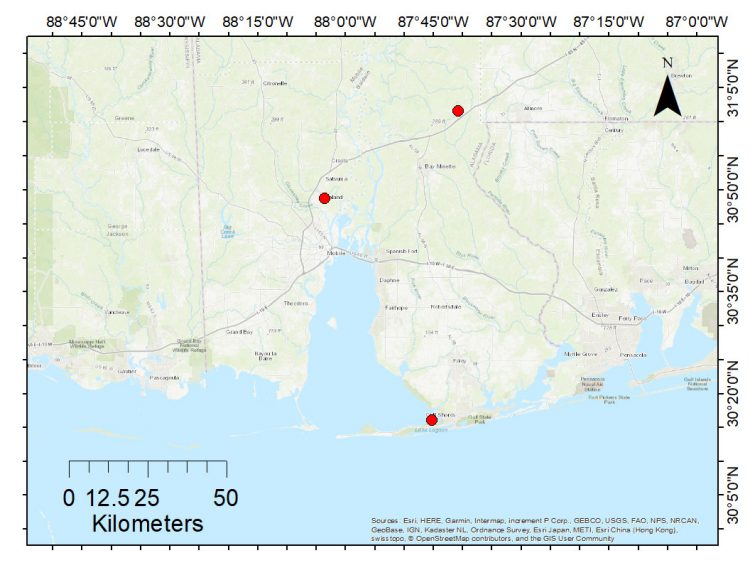Migratory Birds
Full Title: A multiscale approach to understanding migratory land bird habitat use of functional stopover habitat types and management efforts
This project investigated migratory bird use of stopover habitats to inform bird habitat protection and restoration decisions in the Gulf of Mexico region.
The Team: Theodore J. Zenzal Jr, Ph.D. (Lead Investigator, U.S. Geological Survey, The University of Southern Mississippi, tzenzal@usgs.gov), Jeff Buler, Ph.D. (University of Delaware), Wylie C. Barrow Jr., Ph.D. (U. S. Geological Survey), and Barry C. Wilson (U.S. Fish and Wildlife Service)
Technical Monitor: Jeff Gleason (jeffrey_gleason@fws.gov)
Federal Program Officer/Point of Contact: Frank Parker (frank.parker@noaa.gov)
This project began in July 2017 and ended in June 2022.
Award Amount: $1,492,151
Why it matters: Over two-thirds of all land birds and over half of the migratory species in North America move long distances to areas in Mexico, Central and South America and the Caribbean islands. For birds crossing the Gulf of Mexico, habitats along the northern Gulf of Mexico coast provide the last possible stopover before autumn migrants make a nonstop flight and the first possible landfall for birds returning north in the spring. Many migratory bird populations are declining in association with losses in quality and amount of these critical migration stopover habitats.
What the team did: This project worked to develop a better understanding of migratory land bird habitat use along the northern Gulf of Mexico coast to inform habitat decisions for land managers and conservation planners. The researchers studied migrant bird use of stopover habitats that differ in their function for migrants (e.g., resting or feeding), measured migrant habitat use relative to current habitat management efforts, and assessed if weather surveillance radar can serve as an effective conservation tool for migratory birds. Weather surveillance radar and land cover maps were used to make predictions of bird use for the entire northern Gulf of Mexico region. Weather radar also allowed investigators to measure the response of migrants to management efforts, including habitat protection and restoration programs.
Summary of Outcome: Given the need to reduce uncertainty, we framed our objectives to 1) understand migratory songbird use of functional stopover habitat types, 2) Continue to develop and assess weather surveillance radar (WSR) as a management and conservation tool, and 3) Measure migrant habitat use relative to management efforts. We addressed our objectives through the integration of on-the-ground and remotely sensed data. Specifically, we collected data from 6 field sites, which represented various functional stopover habitat types. This on-the-ground data provided information on the stopover duration and average bird size, as well as weekly estimates of fruit, flowers, leaf-litter arthropods, substrate arthropods, and flying arthropods. We also processed ~10 years of radar data in spring and autumn to obtain information on large-scale bird density. The data we collected have been used to: 1) determine if a novel “stopover duration index” is appropriate for both seasons at a large spatial scale, 2) determine migrant response to reforestation of pine forests and forested wetlands around the Gulf, 3) determine the factors that influence stopover duration, 4) determine how age, sex, and body size impact migrant distributions, 5) develop a bioenergetic model, and 6) produce stopover maps for the entire northern Gulf. While we are still putting finishing touches on the bioenergetic model at the time of writing this report, we believe this is the magnum opus of our RESTORE project. This tool will directly assist the Gulf Coast Joint Venture in strategic planning and decision making as it relates to resource management around the Gulf of Mexico.
From the seminar “Integrating weather surveillance radar data with habitat and bird metrics to more effectively manage migratory songbirds along the northern Gulf of Mexico”
Presenter: Dr. T.J. Zenzal, Wetland and Aquatic Research Center, U.S. Geological Survey
Other Resources
Zenzal, T.J. and Barrow, W.C. (2021). A Multiscale Approach to Understanding Migratory Landbird Habitat Use of Functional Stopover Habitat Types and Management Efforts. Pp. 92 in A.T. Pearse, M.H. Sherfy, M. Wimer, M. Khalil, and M.T. Wiltermuth (editors), U.S. Geological survey migratory bird science, 2020–21: U.S. Geological Survey Circular 1480, 131 p. https://doi.org/10.3133/cir1480.
- Gulf of Mexico Avian Monitoring Network Newsletter #5: A multiscale approach to understanding migratory
land bird habitat use of functional stopover habitat types and management efforts. - RESTORE Article: Partly cloudy with a chance of migrating birds
- Calling Weary Warblers! Country Roads Magazine, February 21, 2019
- A Multiscale Approach to Understanding Migratory Landbird Habitat
Use of Functional Stopover Habitat Types and Management Efforts - Project summary for USGS Remote Sensing Report
 Official websites use.gov
A .gov website belongs to an official government organization in the United States.
Official websites use.gov
A .gov website belongs to an official government organization in the United States.
 Secure .gov websites use HTTPS
A lock or https:// means you’ve safely connected to the .gov website. Share sensitive information only on official, secure websites.
Secure .gov websites use HTTPS
A lock or https:// means you’ve safely connected to the .gov website. Share sensitive information only on official, secure websites.

